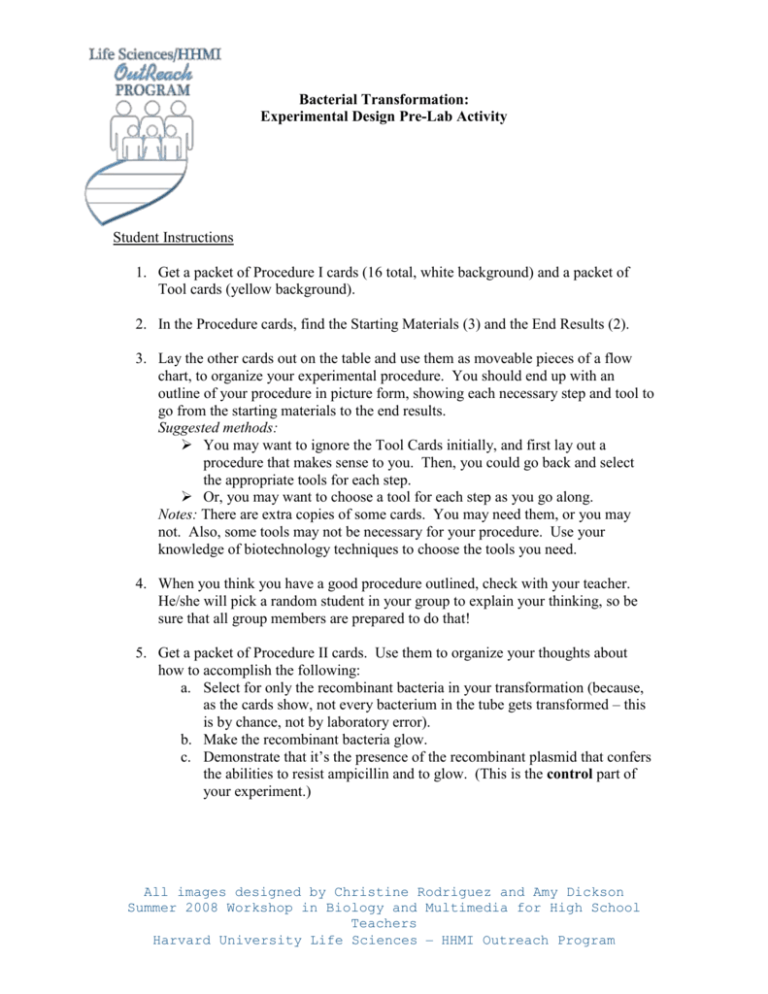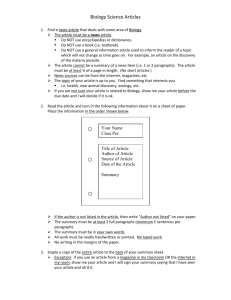Pre-lab Instructions for Students
advertisement

Bacterial Transformation: Experimental Design Pre-Lab Activity Student Instructions 1. Get a packet of Procedure I cards (16 total, white background) and a packet of Tool cards (yellow background). 2. In the Procedure cards, find the Starting Materials (3) and the End Results (2). 3. Lay the other cards out on the table and use them as moveable pieces of a flow chart, to organize your experimental procedure. You should end up with an outline of your procedure in picture form, showing each necessary step and tool to go from the starting materials to the end results. Suggested methods: You may want to ignore the Tool Cards initially, and first lay out a procedure that makes sense to you. Then, you could go back and select the appropriate tools for each step. Or, you may want to choose a tool for each step as you go along. Notes: There are extra copies of some cards. You may need them, or you may not. Also, some tools may not be necessary for your procedure. Use your knowledge of biotechnology techniques to choose the tools you need. 4. When you think you have a good procedure outlined, check with your teacher. He/she will pick a random student in your group to explain your thinking, so be sure that all group members are prepared to do that! 5. Get a packet of Procedure II cards. Use them to organize your thoughts about how to accomplish the following: a. Select for only the recombinant bacteria in your transformation (because, as the cards show, not every bacterium in the tube gets transformed – this is by chance, not by laboratory error). b. Make the recombinant bacteria glow. c. Demonstrate that it’s the presence of the recombinant plasmid that confers the abilities to resist ampicillin and to glow. (This is the control part of your experiment.) All images designed by Christine Rodriguez and Amy Dickson Summer 2008 Workshop in Biology and Multimedia for High School Teachers Harvard University Life Sciences – HHMI Outreach Program 6. When you are finished, get a copy of the lab procedure. In your group, read aloud each step of the procedure and use it to: Check against your flow chart. If there is any discrepancy, discuss until it’s resolved. Determine precise amounts, timings, and temperatures for the steps in your procedure. 7. Check your work with the teacher, then write out your procedure in your lab notebook. 8. In your lab notebook, draw a data table with spaces for expected and observed results. Fill in the expected results. Be sure that every member of your group can explain your experimental setup and your expectations – you may be called on to explain them to the class at the start of lab tomorrow! All images designed by Christine Rodriguez and Amy Dickson Summer 2008 Workshop in Biology and Multimedia for High School Teachers Harvard University Life Sciences – HHMI Outreach Program Teacher Guide Overview and Rationale: This pre-lab activity is designed to be used with an AP Biology class in preparation for Lab 6: Bacterial Transformation. After teaching AP Biology for several years, I have found that the procedure for this lab is complex enough, and involves so many invisible molecular processes, that students lose sight of what they are doing and why. This prelab activity is part of a course-wide change in my AP Biology curriculum that puts a stronger emphasis on students designing their own lab procedures. Rather than handing students the procedure and having them follow it, they are given the overall question or goal of the experiment, and asked to design a procedure on their own. The specific lab procedure, which can be found in the AP Biology Lab Manual for Students or with the kit used for this lab, is then used as a reference for students to check their experimental design and to get guidance on specific amounts and timings needed. The idea is that while students are guided to come up with the same procedure that is in the manual, they will understand it better if they’ve designed it themselves. Moreover, if some students come up with a different procedure, depending on the teacher’s comfort level they could try it despite its probable eventual failure – the idea being that students learn more from self-directed failures than from rote successes. Lesson Components: Introductory Powerpoint Presentation – this provides an introduction to the lab for students, before they are asked to design a procedure. It reviews some basic terms necessary for understanding the lab, and outlines the starting materials and end goals of the experiment. This presentation intentionally does not explain everything necessary for understanding the procedure – the goal being that students figure some things out on their own. Procedure Cards – These are in the form of a powerpoint file, but are not meant to be shown as a presentation. Rather, the teacher should print the file with 6 slides per page, and then cut out the slides to make small cards. If possible, print on a color printer and them laminate the cards so that they can be reused. The first 16 cards should be bundles as the Procedure I cards, and the remaining cards as the Procedure II cards. Tool Cards – These are also in the form of a powerpoint file, but similarly should be printed and cut out for student use. The tool cards have a yellow background to distinguish them from the Procedure Cards. Lesson Procedure: The student instructions outline the procedure for this pre-lab activity. It is designed to be carried out in one class period, the day before the lab. The introductory presentation should take about 15 minutes, and the activity should take about 30 minutes. Students should work in groups of 2-4. As students work on their procedures, the teacher should All images designed by Christine Rodriguez and Amy Dickson Summer 2008 Workshop in Biology and Multimedia for High School Teachers Harvard University Life Sciences – HHMI Outreach Program circulate amongst the groups, asking questions but trying not to give answers. After each group finishes with the Procedure I cards, the teacher should have students explain their procedure before moving on. Important things to point out to students during this discussion include: The pGLO plasmid has already been engineered, so the first steps of their procedure won’t be carried out in this lab. Notice that in the end result of the recombinant bacteria, not all cells have been transformed. This is an expected result due to random chance, and not to error. However, it means that the students must determine how to select for only the recombinant bacteria in Procedure II. Variations: The Procedure Cards can be used as a presentation, rather than printed out for student use, if the teacher wants to walk students through the procedure rather than having them design it themselves. Or, Procedure I could be presented and Procedure II left to students. Students could work together to create a skit of the procedure, with different people acting as the plasmid, the GFP gene, etc. The Procedure and Tool Cards could be printed out one per page and used as nametags for the various roles in the skit. If Procedure I turns out to be too confusing (it has a lot of movable parts!), it could be divided into two parts, so that the entire thing becomes three parts: Procedure I: Create the recombinant plasmid. Procedure II: Transform the cells to create recombinant bacteria. Procedure III: Select for only the recombinant bacteria, make them glow, and demonstrate that glowing and antibiotic resistance is due to the plasmid. All images designed by Christine Rodriguez and Amy Dickson Summer 2008 Workshop in Biology and Multimedia for High School Teachers Harvard University Life Sciences – HHMI Outreach Program






